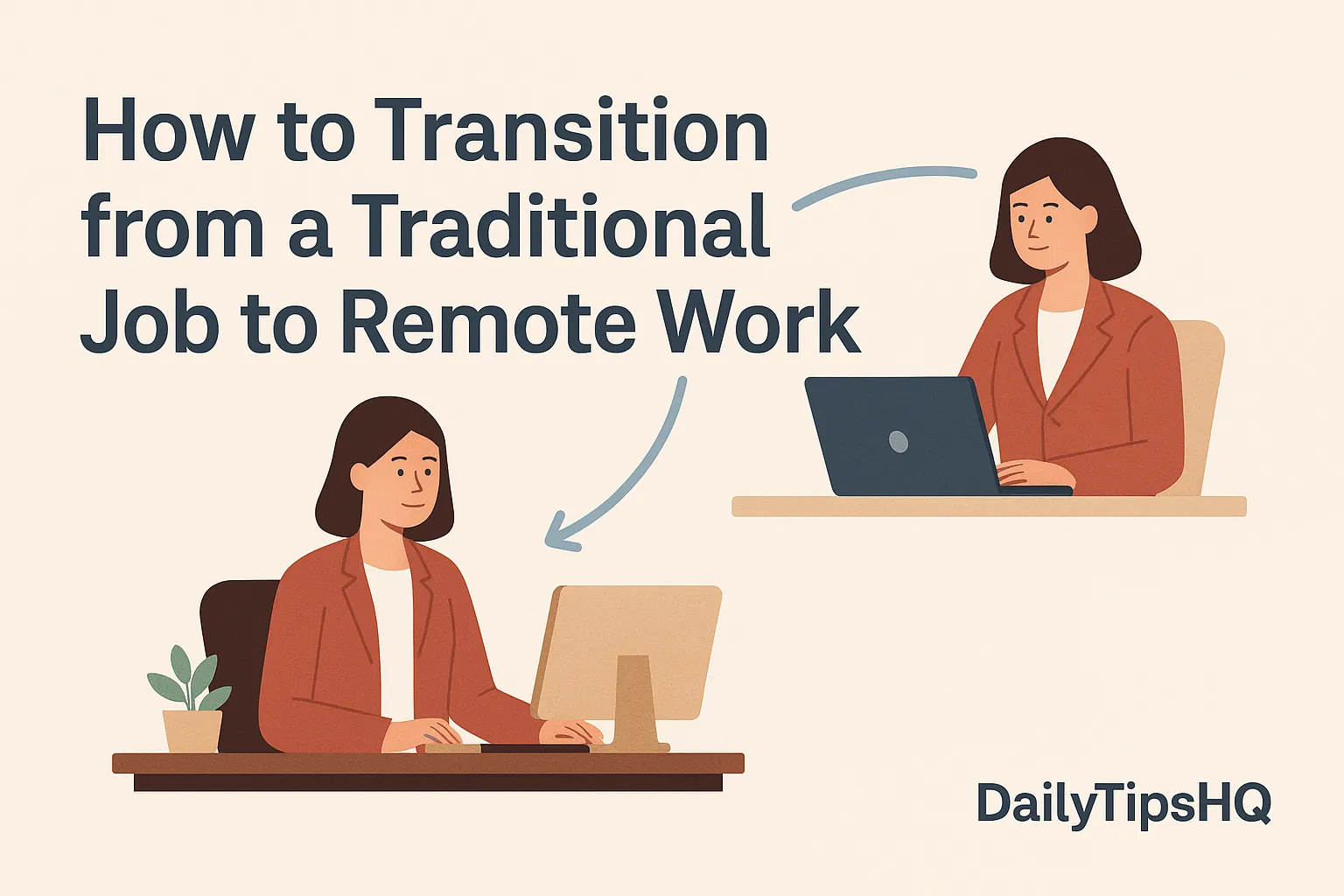Making the leap from a traditional 9-to-5 office job to remote work is more than just changing locations — it’s about shifting your mindset, adapting your workflow, and rethinking how you connect with your team. Whether you’re seeking more flexibility, better work-life balance, or just tired of commuting, remote work can offer a refreshing alternative.
But how do you actually make the transition?
In this guide, we’ll walk you through the essential steps to move from a traditional office job to a thriving remote career — even if you’ve never worked remotely before.
🔄 Step 1: Understand the Remote Work Landscape
Before handing in your resignation, it’s important to understand what remote work really entails.
What Types of Jobs Can Be Done Remotely?
-
Writing and Content Creation
-
Customer Support
-
Software Development
-
Marketing and SEO
-
Data Entry
-
Virtual Assistance
-
Teaching or Tutoring Online
🌐 Explore job platforms like We Work Remotely, Remote OK, or FlexJobs to see what’s trending.
Soft Skills Matter Too
Remote work requires discipline, time management, and strong communication skills. Start working on those right away.
💼 Step 2: Audit Your Current Skills
Take inventory of what you already know and how it can be applied remotely. Ask yourself:
-
Do I have digital communication tools experience (Slack, Zoom, etc.)?
-
Can I work without direct supervision?
-
Am I proactive in solving problems?
If the answer is yes — great. If not, now’s the time to build those skills.
📚 Step 3: Upskill Where Necessary
Consider online courses to enhance your skills. Some useful platforms include:
-
Coursera: Industry certifications
-
Udemy: Affordable niche skill courses
-
LinkedIn Learning: Business and remote work skills
-
HubSpot Academy: Marketing, CRM, and remote tools
🎯 Pro Tip: Certifications in remote-relevant tools like Trello, Asana, or Notion give you a competitive edge.
🖥️ Step 4: Prepare Your Remote Setup
You’ll need:
-
A reliable internet connection
-
A dedicated workspace (even a quiet corner works)
-
Noise-canceling headphones
-
Project management tools (Notion, ClickUp, Trello)
💡 Common Mistake: Skimping on your workstation setup. Invest in your comfort and productivity.
📃 Step 5: Revamp Your Resume for Remote Jobs
Your resume should reflect:
-
Remote-specific skills
-
Time management and communication strengths
-
Experience with remote tools
-
Any freelance or self-managed projects
Include phrases like “worked independently,” “remote collaboration,” and “self-starter.”
🌍 Step 6: Start Applying on the Right Platforms
Here are the most popular job boards for remote work:
-
Toptal – for top-tier professionals
✅ Tip: Set up alerts on these platforms to stay ahead of the curve.
💬 Step 7: Practice Remote Communication
Communication is key in remote teams. Improve your:
-
Asynchronous messaging (Slack, Email)
-
Video call etiquette
-
Clear and concise writing
🧠 Tip: Record a short video introducing yourself and explaining your background. It can serve as a unique portfolio asset.
💳 Step 8: Prepare Financially
A transition may take time. Consider:
-
Building 3–6 months of savings
-
Starting with freelance/part-time gigs before quitting
-
Creating a budget for the transition period
🌱 Step 9: Start Small and Iterate
If you’re nervous about jumping all in:
-
Try remote freelance projects
-
Ask your current employer about hybrid/remote options
-
Volunteer for a nonprofit in a remote role
🙌 Final Thoughts
The world of remote work is evolving rapidly — and now’s the perfect time to join the movement. With a bit of planning, upskilling, and strategic job searching, you can transition successfully from your traditional job to a fulfilling remote career.
❓ FAQ
What counts as remote work?
Any job that allows you to work outside of a centralized office environment using digital tools.
Is remote work a good thing?
It offers flexibility, autonomy, and often better work-life balance — but requires discipline and communication skills.
How do remote jobs work?
Remote workers collaborate via project management tools, emails, video calls, and shared documents.
What are the advantages and disadvantages of remote working?
Pros include flexibility and no commute. Cons may involve isolation or difficulty unplugging after hours.
Is remote work from home?
Yes, but it can also mean coworking spaces, coffee shops, or working while traveling (digital nomad lifestyle).
How flexible are remote jobs?
Some roles are asynchronous and highly flexible; others follow standard working hours based on your team’s location.

